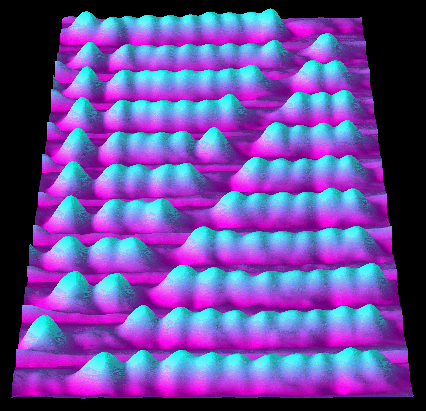|
NATS 1700 6.0 COMPUTERS, INFORMATION AND SOCIETY
Lecture 7: A Short History of Ancient Computing
| Previous | Next | Syllabus | Selected References | Home |
| 0 | 1 | 2 | 3 | 4 | 5 | 6 | 7 |
8 | 9 | 10 | 11 | 12 | 13 |
14 | 15 | 16 | 17 | 18 | 19 |
20 | 21 | 22 |
Introduction
-
As recently as the early '50s, the word 'computer' primarily referred to a person performing computations. And
computation, in one form or another, seems to have been practiced in all civilizations as far back as we can see. It is
plausible to conjecture that as nomadic life gave way to settlements, and agriculture began (about a dozen centuries ago), so did the need to establish
boundaries and to measure fields, to predict the right times for sowing and harvesting, and in general to explore and
represent the world. Browse through Mathematics History
or Mathematics History
-
For easy reference, here is a short timeline taken from the Chronology of Historical Events in Computing
at Hofstra University. Unfortunately, this link is dead. You may want to check similar references:
Key Events in the History of Computing, Overviews of the History of Computing, etc.
A very good Timeline of Computing History, with
plenty of illustrations, has been prepared by the Computer Society "to commemorate the 50th year of modern computing."
Finally, Stephen White maintains an up-to-date Brief History of Computing.
- 6000 B.C. [ca]: Ishango bone type of tally stick in use
- 4000-1200 B.C.: Inhabitants of the first known civilization in Sumer keep records of commercial transactions on clay tablets
- 3000 B.C.: The abacus is invented in Babylonia
- 1800 B.C.: Well-developed additive number system in use in Egypt
- 1300 B.C.: Direct evidence exists as to the Chinese using a positional number system
- 600 B.C. [ca.]: Major developments start to take place in Chinese arithmetic
- 250-230 B.C.: The Sieve of Eratosthenes is used to determine prime numbers
- 79 A.D. [ca.]: Antikythera Device, when set correctly according to latitude and day of the week, gives alternating 29 and 30day lunar months
- 800 [ca.]: Chinese start to use a zero, probably introduced from India
- 850 [ca.]: al-Khowarizmi publishes his Arithmetic
- 1000 [ca.]: Gerbert describes an abacus using apices
- 1120: Adelard of Bath publishes Dixit Algorismi, his translation of al-Khowarizmi's Arithmetic
- 1200: First minted jetons appear in Italy
- 1202: Fibonacci publishes his Liber Abaci
- 1220: Alexander De Villa Dei publishes Carmen de Algorismo
- 1250: Sacrobosco publishes his Algorismus Vulgaris
- 1300 [ca.]: Modern wire-and-bead abacus replaces the older Chinese calculating rods
- 1392: Geoffrey Chaucer publishes the first Englishlanguage description on the uses of an astrolabe
- 1500 [ca.]: Inca quipu reaches its highest form of development. Use of quadrant gaining popularity in Europe
- 1542: Robert Record publishes his English-language book on arithmetic
- You may enjoy reading what David Eppstein, a mathematician at the University of California at Irvine, has to say about
the ancient Egyptian Fractions.
- Throughout the course you will encounter the word algorithm. Its origin can be traced to
the name AlKhowarizmi (see timeline above). An algorithm is a set of well-defined instructions for executing mathematical
or computational operations needed to solve a problem. Read Allen B Downey's
 review, of
David Berlinski, The Advent of the Algorithm: The Idea that Rules the World, Harcourt Brace, 2000. review, of
David Berlinski, The Advent of the Algorithm: The Idea that Rules the World, Harcourt Brace, 2000.
- There are several virtual museums of computing. Find and visit some of them.
Topics
- "The first mechanical calculator (indeed, the world's first digital computer) was the abacus,
whose exact origins are lost in prehistory; however, counting devices were in use in the Far East by 450 BC....
Many early civilizations developed analogue or digital systems for measurement or calculation. The megaliths
of Stonehenge and other stone circles were erected about 2000 BC to predict important astronomical events.
Polynesians in outrigger canoes fitted with sails navigated thousands of kilometers of the Pacific Ocean using
direct observation of natural phenomena, sometimes supplemented with 'maps' made of knotted cords attached
to a wooden frame. In the sixteenth century, the Incas of Peru developed the quipu, an
intricate pattern of knotted chords, for calculation." (Ian McNeil, ed., An Encyclopaedia of
the History of Technology, London, Routledge, 1990, 1996, p. 697).
- Many of these 'primitive' devices were not primitive at all. The abacus is not only still in use in many
parts of the world, but in the hands of an experienced user it can hold its own against modern mechanical and
even electronic calculators. In its disarming simplicity it embodies more advanced and efficient arithmetical
algorithms than we learn today in school. Check The Abacus:
The Art of Calculating with Beads. And if you thought the abacus was merely a historical
curiosity, here is a scanning tunneling microscope image of the world's smallest abacus, that scientists at the Zurich
laboratory of the IBM Research Division built "with individual molecules as beads with a diameter of less than one
nanometer, one millionth of a millimeter"

IBM's Smallest Abacus
|
![]() review, of
David Berlinski, The Advent of the Algorithm: The Idea that Rules the World, Harcourt Brace, 2000.
review, of
David Berlinski, The Advent of the Algorithm: The Idea that Rules the World, Harcourt Brace, 2000.